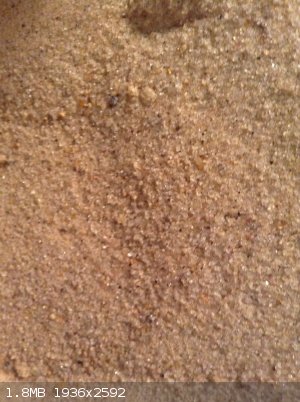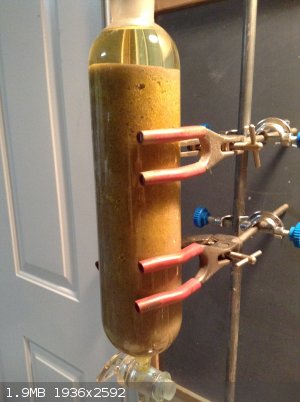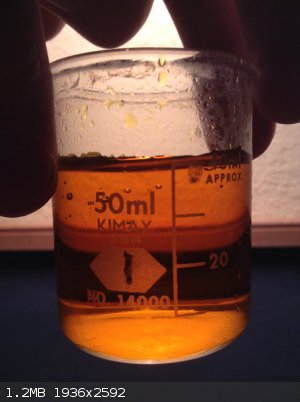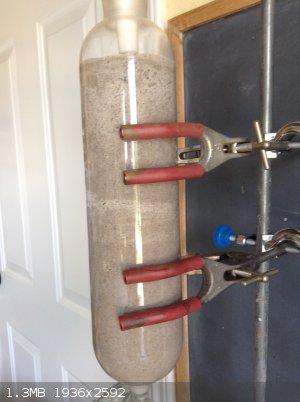Texium
Administrator
       
Posts: 4581
Registered: 11-1-2014
Location: Salt Lake City
Member Is Offline
Mood: PhD candidate!
|
|
A bit of Analytical Chemistry at Home (Analysis of sand)
It's often pointed out that there isn't a lot of analytical chemistry posted on here. I wanted to try a little bit as a sort of side project.
I have a bag of sand in my garage. It's just normal brownish colored sand labeled "Play Sand" that came from Home Depot. A few days ago, I decided to
try and see how clean I could get a sample of it by washing it with various chemicals. I also thought it would be fun to attempt to analyze the washes
through qualitative tests to determine what the present impurities are.
The sand I started with:

I started out by filling a 600 mL column with the sand (I had to shove a cotton ball in the bottom because it's not really a chromatography column and
doesn't have a sintered disk). Next, I ran distilled water through the sand in the column until all of the small, silty particles that were small
enough to pass through the cotton ball were washed out. Then I added 31.5% HCl to the column, pushing out the remaining water, until all of the sand
was soaked in it. I let this sit overnight. The next morning, I found that the leachate had a strong yellow coloration, which I assumed to be iron.

I began to pull of the HCl leachate. Unsurprisingly, it contained a lot of iron (additionally confirmed with ferrocyanide). Here is a picture of a
sample of the leachate:

After rinsing the iron bearing solution out of the column, it was obvious that the sand had changed color considerably, and was now a light gray color
with some black flecks.

Then I decided to try and look for metals other than iron present in the leachate. First, I took a sample of the leachate and added concentrated
sodium hydroxide solution to it until nothing more would precipitate, and then added a bit more. I allowed this to settle (wish I had a centrifuge)
and then took a sample of the supernatant solution. To this, I added a drop of sodium ferrocyanide solution. There was no precipitate, confirming that
there is no significant amount of zinc present. I am now working on cleaning the precipitate, which I will redissolve and further analyze to see if
there are other metals present, although I'm thinking right now that iron is the only one there in quantities measurable by me. I will continue to
update this thread occasionally with progress.
|
|
|
blogfast25
International Hazard
    
Posts: 10562
Registered: 3-2-2008
Location: Neverland
Member Is Offline
Mood: No Mood
|
|
Zinc was always going to be a bit of a long shot (unless you got the sand from a toxic sludge beach - LOL).
Almost certainly present in your lixiviate will be Na, K, Ca and Mg. With simple means these are harder to detect than you might think. Na can be done
with flame test of course but make sure you test your HCl first.
Neutralise the lixiviate to pH 4-5 with strong ammonia to precipitate iron. Filtering then collects all alkali and earth alkali metals.
Split filtrate and treat one part with carbonate to precipitate earth alkalis as carbonates.
The sand itself will almost certainly contain some aluminosilicates.
You can also try and separate out some of the darker stuff by means of 'panning' (assuming it is of different density from the lighter stuff) Test the
darker stuff for magnetism.
We definitely need more analytical threads on this forum.
[Edited on 10-6-2015 by blogfast25]
|
|
|
Morgan
International Hazard
    
Posts: 1694
Registered: 28-12-2010
Member Is Offline
Mood: No Mood
|
|
Maybe a little magnet action could pull out some black sand, but not much of course.
https://www.youtube.com/watch?v=qAulZdFW3x8#t=39s
|
|
|
SimpleChemist-238
Hazard to Others
  
Posts: 147
Registered: 28-9-2014
Member Is Offline
Mood: Chlorine Trifloride Flame Thrower
|
|
I did some thing similar with lime stone that was very red. Nothing interesting in the rock but the sand is cool. The black specs are probably little
pieces of obsidian. I bet you could use a similar method to get iron from red clay!
We are chemists , we bring light to the darkness. Knowledge to ignorant, excitement to the depressed and unknowing. we bring crops to broken fields
and water to the desert. Where there is fear we bring curiosity.
|
|
|
The Chemistry Shack
Harmless

Posts: 29
Registered: 11-6-2015
Location: Science
Member Is Offline
Mood: All the moods
|
|
CaCO3 from crushed sea shells is probably a prominent impurity as well. It would be interesting to see how much you could get out of that batch of
sand.
Taking the HCl leachate and adding a sulfate salt should precipitate white CaSO4, while the soluble FeSO4 stays in solution.
|
|
|
AJKOER
Radically Dubious
    
Posts: 3026
Registered: 7-5-2011
Member Is Offline
Mood: No Mood
|
|
My personal opinion, but I think analysis of your tap water may be a more important use of your resources (recent problems in many areas include high
level of nitrates, for example, which is especially toxic to newborns).
Also, knowing that your water is treated with chlorine and the presence of bromides, for example (which can be a source of problematic bromates in the
presence of copper pipes), could lead to preventative action to save llives on your part.
But, on the other hand, your gathering this kind of information may not be appreciated by some.
[Edited on 16-6-2015 by AJKOER]
|
|
|